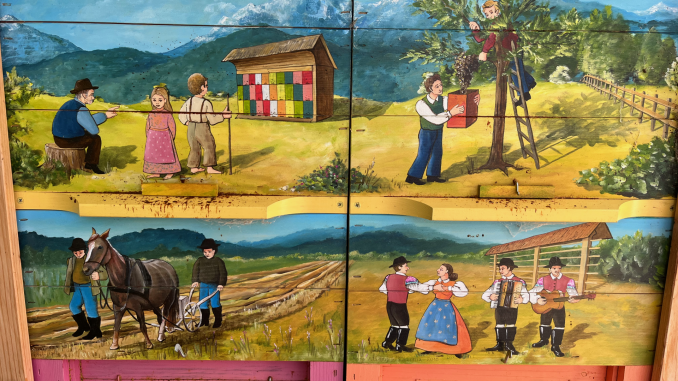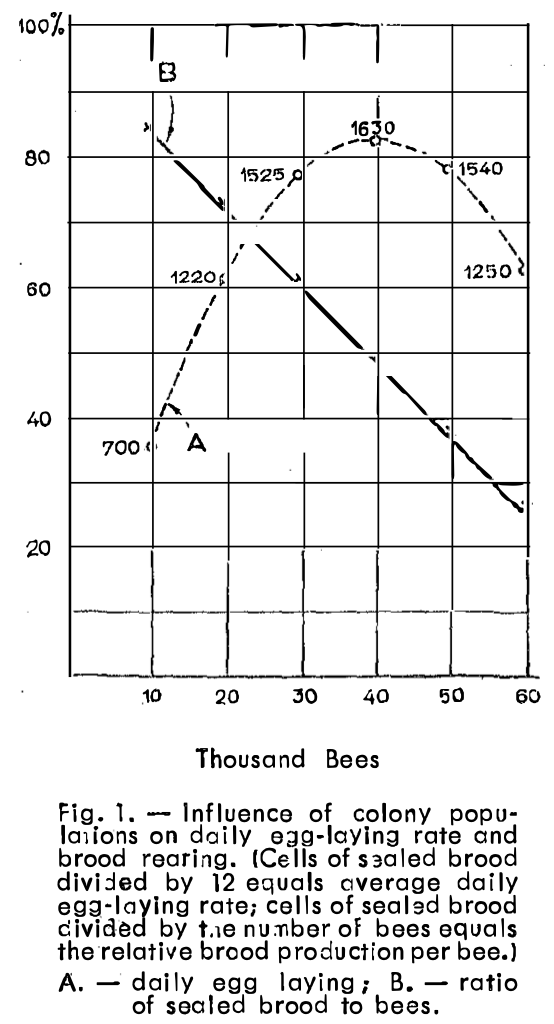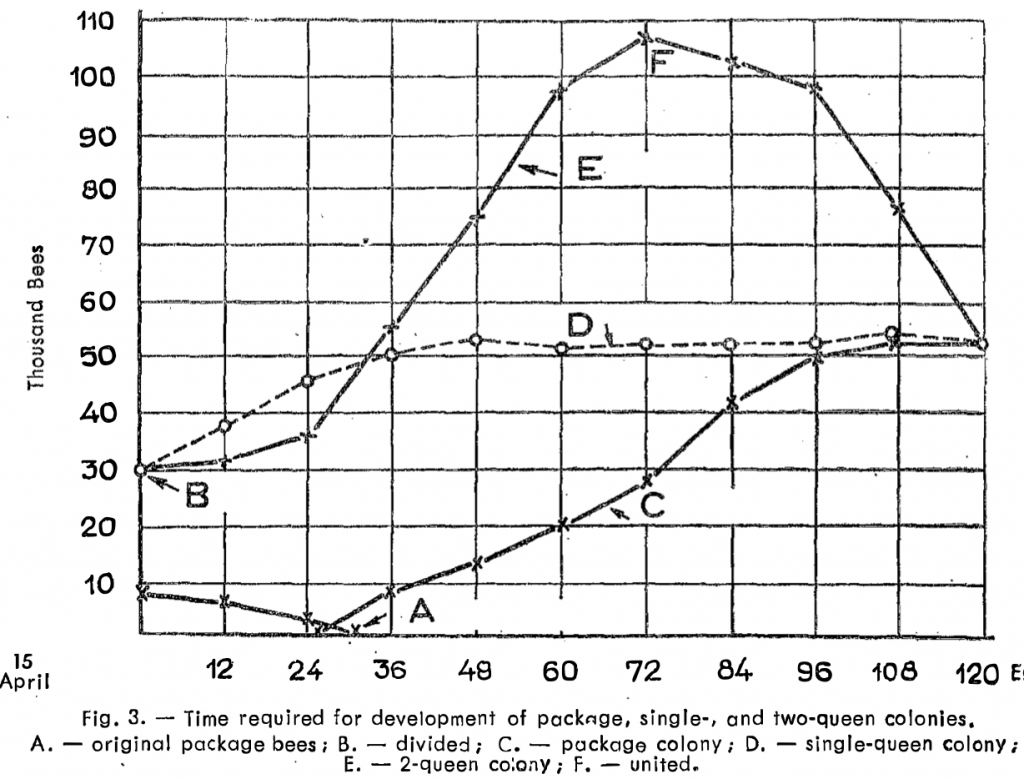
Alan Wade
Much can be learnt from close inspection of brood combs. That is quite all apart from examining brood for the telltale signs of disease.
What do we look for when we open up a hive in spring? We check for a laying queen and reserve stores and make sure our bees are healthy. Any problem calls for prompt action. But do we really assess what is in plain view?
In a routine early spring check, I tot up the number of frames of brood, check the brood pattern, check for stores of pollen and honey and hazard a guess at signs of overcrowding and space for the queen to lay. I also shake down all brood combs in every colony to make sure there is no EFB or AFB and also record details of chalk brood and sacbrood levels.
Queen rules
There are several features of brood condition – disease aside – that tell us whether the colony is out of kilter. These include an abnormal ratio of different stages of brood, hive restlessness occasioned hive roar or bees running on frames, the presence of active queen cells, the presence of too many bees to tend a large amount of brood present and too many bees, as well as too little space, to cure nectar and store honey.
Several rules emerge:
Rule 1 – Brood balance ratio rule
A good queen, well provisioned and with ample nurse bees to raise brood, will lay to her full capacity and at a steady rate. Here the amount of brood at different stages of development will be reflected in the time it takes for a worker bee to develop: eggs 3 days: larva 6 days: pupa 12 days, a simple 1:2:4 ratioi.
You are most unlikely to ever count brood cells in different stages of development. However a quick scan of combs containing only eggs and young larvae or only sealed brood will signal that a queen has only just started to lay or that a queen has been lost, is failing or that brood raising has been curtailed.
When, alternatively, there are an overly large number of bees emerging and a surfeit of nurse and house bees, and the colony becomes overcrowded, the queen may lose control over her progeny.
Rule 2 – Colony bee number to brood balance rule
When there are surplus bees, those that would result in broodnest overheating or that are no longer employed in processing nectar and storing honey, they will beard outside the hive entrance or hang off combs as replete nectar storage bees signalling that the colony may swarm.
A healthy expanding colony having an adequate numbers of bees to provision larvae and to maintain the brood nest homeostasis will be in balance. It will have a large retinue of house and field bees working actively together to raise brood and to steadily build and fill honey storage combs. Keeping a close tab on fast expanding brood nests in spring will help you adjudge whether the number of bees relative to the amount of brood is getting out of balance and whether or not swarming in imminent.
The Scottish master beekeeper Bernhardt Möbusii read these pointers as either an early sign of swarm preparation, or – out of swarming season – a condition where the colony no longer had room to store incoming nectar. His keen observation of brood-bee imbalance being the major factor – apart from queen age – in initiating swarming deserves much wider recognition.
Farrar developed other brood nest rulesiii especially pertinent to the colony buildup phase:
Rule 3 – Queen laying rate rule
The number of cells of sealed worker brood divided by twelve equals the egg laying rate of the queen.
Since sealed brood is relatively easy to observe, changes in the amount present from week to week will signal that the queen’s laying rate has changed proportionally. While it is natural for a queen to increase her rate of laying as more bees emerge and can nurture more brood, some tailing off of the amount of brood present will signal that the colony population is approaching its peak. I usually just count frames with brood as a rough index of whether the colony is expanding and how it is faring in relation to other colonies in the apiary.
Farrar also observed that:
The most populous colonies produce not only the most honey per colony but the most honey per bee.
We can read most of what we need to know about the dynamics of the brood nest from Farrar’s plot of the fortunes of a healthy well fed colony with a good queen (Figure 1). While not simple it does help explain the complex dynamics of the bee brood nest, how the colony builds and the important fact that bees become more efficient (per bee) as the population maxes out.
To give substance to this statement he detailed studies that demonstrated that the ratio of sealed brood and colony populations decreases 10 to 14 percent for each increase in population of 10000 bees and that the rate of egg laying by the queen increases with a rise in the population up to 40000 bees. The import of the workforce in switching its activity from brood rearing to harvesting is tied up with getting the colony to full strength by the commencement of the flow when the proportion of bees tending brood is lowest and when bees are tasked to forage:
Rule 4 – Proportion of bees attending brood rule
The number of of cells of sealed brood divided by the number of bees equals the relative brood production per bee.

Figure 1 Clayton Farrar’s plots of spring queen egg laying:
(A) in response to colony size; and
(B) declining colony proportion of colony devoted to brood tending as population expands.
In the early stage of build up around 80% of bees are attendant to raising brood. By the commencement of the main flows 2-3 months later, as little as 30% will be tasked to brood rearing, most bees being involved in harvesting, comb building and nectar curing.
Information on just how productive bees are shown in Figure 2. You will need to read the graph carefully to understand the yield factors as crop yield depends on many environmental factors and where the bees are kept, but the rules are the same. Put 100% = 100 kg if that is the actual season crop.

Figure 2 Clayton Farrar’s plots signalling positive influence of population size:
(C) on individual bee harvesting potential: and
(D) honey production based on size of population.
Often enough colonies do not take in an early crop simply because there are too few bees to forage and what is taken in is used to raise bees in the buildup phase. A strategy of dividing and requeening colonies late in the season (late summer and early autumn) and reuniting bees in early October when the risk of swarming is largely over is a good strategy for spring blossom and early and regular Red Box (Eucalyptus polyanthemos) flows.
The brood cycle can be manipulated in other ways to advantage. Beekeepers move their Southern Highlands bees to warmer climes and feed them heavily to prepare them for early almond and cherry pollination. Package bee producers use only medium strength colonies (~ 20000 bees) since, at that colony size, bees are primed mainly to raise bees. Using supplementary feeding these bees can be regularly shaken and still have their numbers build again quickly.
Farrar went on to show how different systems of colony management effect the seasonal population dynamics (Figure 3). Honey bee populations respond radically differently at different latitudes and in different climatic conditions. For example bees close to the Arctic must be built to a very tight timetable, but the days are very long and honey flows can be short but very intense. Package bees and swarms follow the trajectory line AC initially losing bees reaching full colony strength in just over three months: an overwintered colony makes it within 90 days (3 months). Healthy overwintered bees with ample stores, starting from a better base line BD, make a peak population of around 50-60 thousand bees in a about 50 days (1 1/2 months). And strong enough colonies split and requeened are initially put back – the laying queen is deprived of some nurse bees – but two queens then laying together soon outstrip even the most producing single queen topping out at 90-110 bees timed for the main honey flow – line BEF. In this case, and unless the flow is likely to be extended, the excluder is removed to allow the colony to return to its ancestral single-queen condition.

Figure 3 Clayton Farrar’s plots of population growth projections over time:
(A) from package or swarmed bees;
(B) from established bees; and
(C) from colonies splits headed by two queens and united near commencement of honey flow.
How well is a queen laying?
I’ve ever only once settled down to watch a queen laying and that was through the wall of a single frame observation hive. She was in a very small colony and was laying an egg roughly every four minutes. Given that there are 1440 minutes in a day (86,400 seconds) she was laying at a modest 350 eggs per day. I once encountered a very smart PhD student who had installed a camera inside a nucleus colony to watch and record a queen laying so that was one better. However one has only to resort to Rule 3 to discover that you can estimate the laying rate of the queen from the amount of sealed brood present (Table 1). The rate of laying date needs to be backdated since the oldest of the sealed brood (emerging bees) will have been laid three weeks (21 days) earlier.
| Queen laying rate (eggs per day) | Average interval between egg deposition (seconds) | Area of sealed brood (cm2) |
| 100 | 860 | 210 |
| 500 | 172 | 1050 |
| 1000 | 86 | 2100 |
| 1500 | 56 | 3200 |
| 1650* | 52 | 3400 |
| 2000** | 43 | 4200 |
* Good queen maximum laying rate
** Exceptional queen maximum laying rate
Table 1 Relationship between queen laying rate (a moving average) and amount of sealed brood
There are a few other scaling basics:
- worker cells span 4.5 mm centre to centre;
- there are 570 cells for every 100 cm2 of worker comb;
- a full depth Langstroth comb spans 425×205 mm = 870 cm2; and
- a perfect full depth Langstroth worker comb has 4500 cells per comb face (9000 cells per comb).
In practice it is necessary to shake off bees to see and measure the amount of sealed brood present. And in order to assess the population of colonies over time it is necessary to weigh colonies before bees depart to forage and to reweigh the hive after shaking off bees to estimate the total weight of bees — by difference — and hence their number. A non foraging bee weighs 100 mg.
Farrar adopted a more ingenious system for his 1937 study of bee population dynamically: he sampled ~ 500 bees, counted and weighed them, and got the weight of bees per colony. For real world bees their weight varied wildly 95-162 mg with an average of 130 mg – bees are normally loaded with some nectar or honey.
Changes to the number of bees present is dependent on the queen laying rate, the capacity of the colony to nurse brood, the time taken for those bees to emerge as adult bees and bee longevity. On the ascendent phase, many more bees are produced than lost. However once the population reaches a peak and the flow commences there is a heavy mortality amongst foragers and bee numbers decline. The importance of producing a large number of young replacement, so called long lived diutinous, bees late in the season is that it allows the colony to overwinter successfully. This emphasises the importance of having a fit queen at all times.
So next time you dive into inspect your bees pay a lot more attention to what is happening in the brood nest. Do some quick sums to work out whether your bees will be ready for the honey flow and, later, to overwinter, that is if you need to requeen or to add or take off supers. And do read Clayton Farrar’s incisive instructions on how best to manage your bees.
Readings
iCollinson, C. (2019). Applying the basics of honey bee biology. UK National Honey Show 14 January 2019. https://www.youtube.com/watch?v=pULjCfKX8_k
iiMöbus, B. (1987). The swarm dance and other swarm phenomena Part I. American Bee Journal [April 1987].
Möbus, B. (1987). The swarm dance and other swarm phenomena Part II. American Bee Journal [May 1987).
Parts l and 2 of a Two-part series published in the American Beekeeping Journal by Bernard Möbus NDB Scotland can be found at http://poly-hive.co.uk/recourses/mobus-bernard-his-work-on-swarming-and-wintering/the-swarm-dance-and-other-swarm-phenomena-2/
iiiFarrar, C.L. (1968). Productive management of honey bee colonies. Apiacta 4:22-28. http://www.fiitea.org/cgi-bin/index.cgi?sid=&zone=cms&action=search&categ_id=55&search_ ordine=descriere
